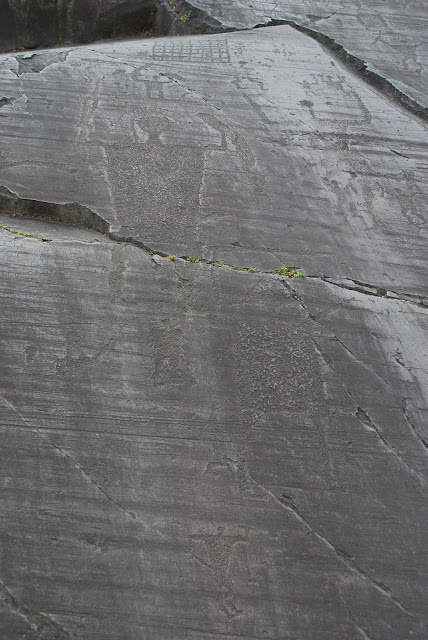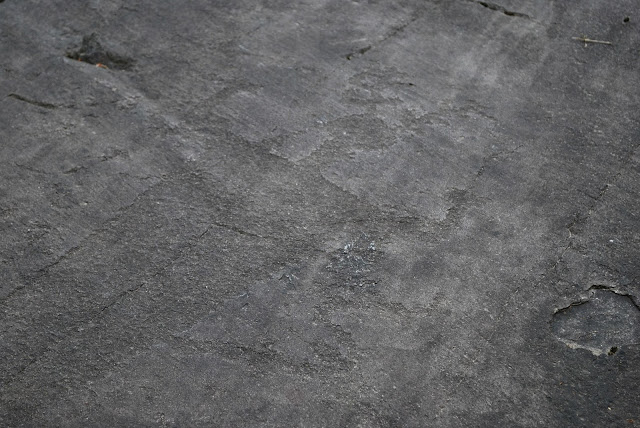 |
| Val Canonic footprints scaled alongside my foot. |
 |
| Cammuni/Etruscan Runes - Photo by Author. |
 |
| Deer carvings - Photo By Author. |
 |
| The Cammuni Rose -Pic by author. |
For this post I thought I'd expand some notes I made last year during a visit to Val Camonica. For many years I had seen these images (like those above and below) during my winter research binges. For some reason the images struck a chord with me. There is also a very famous Cernunnos figure located amongst the recorded 300,000 images carved there.
The valley is some 90 kms in length, one of the longest valleys in North Eastern Lombardy (many of the cravings are in the province of Brescia). Its importance as a migratory thoroughfare is obvious and the carvings substantiate the region's importance as a religious and ritual site from the 1st millennia BC (the Romans named the tribe there the Camunni). The earliest carvings in the valley date back to the 5th-6th millennia BC and are assumed to be the work of migratory bands of hunter-gatherers, as most portray elk and hunting scenes. There are also medieval carvings and that made me wonder if some remnants of the older beliefs remained in the folk customs of the valley - enough to solicit the interests of the Inquisition who, in the 1600's, burned hundreds of people as witches.
Those carvings discovered so far are grouped into eight national parks and we visited the Riserva Naturale Incisioni puestri di Ceto,Cimbergo e Paspardo. The environment there is stunningly beautiful and the retreating ice-sheets of the last glacial period has left undulating flanks of ice-smoothed rock as a canvas for carving.
The first impression upon visiting the sites, at Ceto, Cimbergo and Paspardo, is that the groups of carvings are not passive scenes to be adored like paintings in a gallery. Some are difficult to reach, like the deer sequence at Paspardo, which is accessible by climbing along natural terraces in the glacier-smoothed rock, allowing one to step closer and navigate the narrow ledge to reach the scenes. Perhaps these delineations and protuberances in the rock were viewed as natural horizons for the imagery.
 |
| I love the simple grace of these designs, hidden in the folds of stone - Pic by author. |
 |
| Oranti - Pic by Author. |
At Cimbergo the rocks are studded with carved footprints (these, I noticed, appeared to be aligned, not true east, more southeast, with others turned to a 45 degree axis, tending north) - the sensation here is that these are meant to be stood upon; perhaps ritual poses were to be emulated; such as the classic orant pose (see picture), similar to the Yoga Monkey Pose. In fact I noticed a set of prints where the footprints are just over shoulder width apart (though I'm not suggesting the Cammuni were yoga practitioners). Throughout the parks the 'oranti' are numerous and the pose is distinctive and stylised: knees bent, arms crooked but held sky-wise. The creators of the carvings made a point of making the gender of the figures obvious (penis stem for males and a circular bowl indentation for females - a motif also used in bronze-age carvings in Tanum, Sweden). That the figures portray the act of worship is obvious. In Parque Nazionale Di Naranque there is a section where oranti are clustered around a solar symbol (incidentally oranti figures are also found in the Tomba Branca, Sassari, Sardinia).
 |
| Foot print pairs - Pic by author. |
 |
| Author adopting Oranti pose. |
Another impression I had, during our visit, was that the designs are fixed upon a living surface, like a map - a microcosm of the bigger picture. Elements and figures are folded into creases and crevices. There are some natural shapes that reflect the carved, like a natural footprint mirrored above by carved feet.
 |
| Deer Carved on a Rock on the Valley floor - pic by author. |
I am aware the reductionist historical view tends to limit explanations to the purely functional, e.g. pictures of houses are merely pictorial representations and nothing else, and the counter argument which focuses too heavily upon the symbolism - often reading too readily into the minutest details. Both are products of historians reflecting their historical moment, or academic fashion, on the past: the tendency to interpret the past with our political and social mores layered throughout. For example, illustrations in popular history books of the 20th century people appeared very clean-cut - like historical films of the same period. Whereas as the 20th century rolled on, the historical characters (whether in Western movies or history books about Saxons) got rougher looking and more foul-mouthed. Basically reflecting not history, or any sort of truth, but our modern reflections and fashions - that is a mainly modern Western prejudice, draped over the skeletons of the archaeological record.
 |
| A game folding into the land? And is that a game board? - pic by author. |
 |
| The figure appears to flee along a natural feature - pic by author. |
Both versions mentioned above miss the point: that what the ancients poured into the carvings was not merely the result of purely functional or utterly symbolic living, but the life they lived - that was possibly indistinguishable from that which they portrayed on the rocks. A measure of reality and unreality, both indistinguishable to the peoples of that time. The spirits and the anima, the gods and goddesses were not a separate reality. They were intermingled with life.
For example Val Camonica is subject to a natural phenomena when, in spring and autumn, the morning sun projects a shadowy counterpart of Mount Pizzo Badile. Perhaps such phenomena secured the valley (or reinforced it) as a religious site.
 |
| Mount Pizzo Badile - pic by author. |
One gets the impression, looking around at some of the groups of carvings, of a game, a sacred game; figures twisting and dancing, or locked ritual poses and warrior stances on the rock - which was perhaps seen as a living hide (when wet some outcrops are like the backs of whales breaking through the soil).
Going back in time to our early ancestors, who painted the caves of Lascaux and Altamira, there seems to be some indication that such efforts might have been an attempt to commune with the spirit world; that by interaction with the veil that divided worlds i.e. the skin of the world, its surface, worshippers (or their intermediaries - shaman types or priests) could cross over.
The thought of this being a sacred game and the progression of natural forms into man-made got me wondering about these people. They could build houses, mine ore, fight, perform rituals, carve rocks, etc, but weren't they in many ways as children, partaking in a kind of fantasy? That doesn't mean to belittle their beliefs, I think they were onto something - a profound depth that we have lost, something that in its elemental form is intuitively scientific, spiritual and ultimately poetic.
 |
| One of The Maps -pic by author |
What I am trying to get a cross here is the element of play and the time they had to pursue such endeavours. They had time! Carving these images wasn't something you just did, like doodling in margins with a pen. To hammer the designs took time, effort, using shards of harder stone, most likely granite, to chip the smooth surface. We have to take into account the noise this would make too. Were these taps, echoing around the valley, part of the ritual? A sonic element, like the rhythmic beat of a shaman's drum (that's me inflecting the modern historical penchant for shamanism in there - ho-ho)?
Could it be that several people worked on images at different times as part of the ritual, or was this task consigned to a sacred artist? By drawing the picture of an iron-age house was that meant to bring luck or protection to the real house, by way of sympathetic magic? If so why? Or were these just pictorial images reflecting the folklore of the Camunni? Was the ground, the stone itself, sacred; a skin between this world and the spirit world - a realm that was occasionally glimpsed near Mount Pizzo Badile? Were the carvings elements in a sacred ritual site that evolved through the ages, like a Bronze-age Delphi? Could it be that the sites were used for different functions, or in different ways, that some were pictorial histories, or became that in time - a way of teaching the young about their clan identity? Did their proximity to tribal villages reflect or enhance their profaneness or sacredness?
 |
| Map with view across the valley - author's pic. |
After visiting the carvings at Capo Di Punte, climbing high above the town, we viewed one of the so-called 'maps'. This apparent landscape, with plots and rectangles, dotted inside with regimen cups, seem reminiscent of fields with meandering paths between them. Superimposed upon the rippled rock, as though reflecting the territory across the valley. In fact the perfect place to view such a map. Though what purpose did it serve? Were the Camunni settlements such permanent things that they'd wish to set them in stone? Were fields? Or is this not meant to be the real world? Or, as my girlfriend suggested, was it also part of a game? Were the cups meant to house counters?
Indeed a little further away we found another, obviously vast mapping (remaining to be fully uncovered), ranging over a series of ripples (microcosms, miniature valleys and mountains) - but this time no spectacular view - what then? Territory of another valley far away? Another game?
Apart from the famous Cernunnos figure were other figures meant to be deities? Some motifs are reported to be elemental sprits, appearing as suggestive sections of stippled carving. Or perhaps the tribe had little need to carve visions of gods and goddesses because their forms were already implanted in the land around them!
 |
| The Famous 'Cernunnos' figure - Pic by author. |
















No comments:
Post a Comment